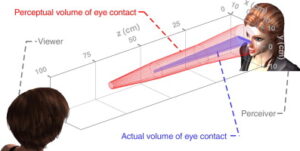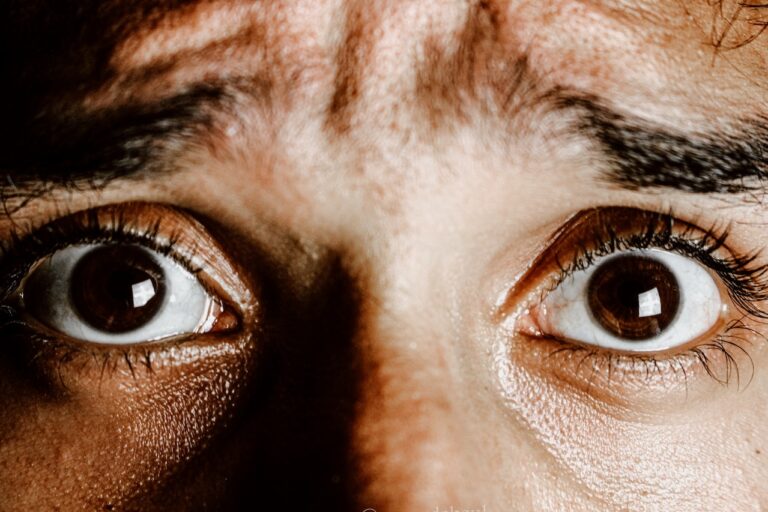Disclaimer: My content is NOT a substitute for professional advice, diagnosis, or treatment. When in doubt, ask a therapist!
Couldn't look you in the eye… What the hell am I doin' here Creep by Radiohead 🎶
For socially anxious people, making eye contact triggers fear of judgment. But why?
Let’s take a step back and understand the social role of eye contact…
Eye contact: the traffic light system in conversations
Given how important tribe/group life has been throughout human history, we’ve biologically evolved to notice other people’s gazes. Even when they aren’t actually looking at us (more on this later.)
University of Melbourne professors, Nick Haslam and Mark Eger, explained:
“Humans are the only animals with obviously visible eye whites, with irises that are much more prominent and therefore readable.”
Making eye contact helps you see if your conversation partner is actually paying attention or not, and if they understand what you’re saying. It also helps you signal whose turn it is to talk/listen, according to research.
All this is to say that you can’t avoid eye contact, as it can make or break a conversation. But here’s the challenge…
Why social anxiety makes eye contact a lot harder
One big reason why eye contact is anxiety-inducing is the fear of being negatively evaluated for sharing your thoughts or emotions. Iffah, M.Couns, comments:
“We feel apprehensive to look people in the eye, because we’re unsure about what they’re really thinking of us… So it’s even harder if it’s with new people, who we don’t know very well. By escaping their eyes, we might be escaping their (perceived) judgment of us.“
And when you’re socially anxious, here’s how your eye contact changes (according to the ‘vigilant-avoidance’ model):
- Vigilance: You spend more time watching out for social threats (in the form of negative facial expressions, say a frown)
- Avoidance: While being hypervigilant, you avoid looking at the eyes, due to the fear of being negatively evaluated
All this rings true for me, as what I’d do is obsessively scan the person’s face for any sign of disapproval and then quickly shun their gaze (especially if we’re having a disagreement!)
Speaking of disagreement, research shows that avoidance is especially prominent in situations where there's increased judgment. For example, when you're resolving a conflict, or when you're sharing a different opinion from your conversation partner.
Knowing all this is great, but what do you do differently?
Address your thoughts that drive eye contact anxiety
Here’s how you can address the thoughts that trigger your eye contact anxiety:
- Write down the unhelpful thoughts. For me, I’m scared of looking at others, because I worry that I will come across as too intense.
- Introduce more helpful, realistic thoughts. In my case, I remind myself, “Some people might find my gaze intense, but I’m sure others won’t mind, and I have had great conversations regardless.”
(This is known as cognitive restructuring in cognitive behavioral therapy — learn more about this here.)
It can also be helpful to understand the science of eye contact on a deeper level…
Understand the difference between perceived and actual eye contact
Here’s what’s fascinating about eye contact: it’s subjective.
The hot guy/gal who’s giving you the “come-fuck-me” eyes? They might just be looking over to see if their friend is here. And, research shows that there’s more than a reasonable margin of error in perceived vs. actual gaze.
Check out this image from the same study:

In other words, your interpretation of eye contact is often inaccurate, and that’s especially the case in moments of anxiety.
According to research, when you’re feeling socially anxious, you’re more likely to feel that people are looking at you and judging you.
Remembering all this can help you challenge the anxiety-inducing thoughts around eye contact. (More on this later.)
When in doubt, follow the 3-second rule
Not sure how long to look? A study reveals that people prefer a 3-second gaze on average, which is about how long it takes to breathe in and out. In other words:
- Breathe in and look at them
- Breathe out, then look away
I’d recommend using this as a rough guideline, rather than a strict rule. The last thing you want is to follow this rigidly, which will make it much harder to focus on the conversation.
Also, each person has their own preferences, given their family and cultural background. Experiment to figure out what you’re comfortable with, which leads to my next point…
Record yourself on video
By recording yourself on video, you gain a way more objective perspective of how you’re coming across. This is powerful for one reason…
How you think you look isn’t necessarily how you actually look, according to Dr. Ellen Hendriksen. In other words, you might think your eye contact is too intense, but in reality, it’s not the case.
So, here’s how to do it.
- Get a supportive friend and explain what you’re trying to do (consent is important!)
- Then, record your conversation with them.
- Watch the recording, as cringey as it might make you feel. But before that, rate the intensity of your eye contact on a scale of 1-10.
(Note: as you hit the playback button, judgment will probably creep up. Gently note any self-criticism and refocus your attention on the recording.) - Rate again after watching the recording. Chances are, there’s a discrepancy between your before and after ratings. (For more objective feedback, get your friend to rate before/after too.)
Now, whether you record yourself on video or not, here’s what I’d suggest…
Get feedback from others!
In moments of heightened anxiety, you won’t be the best judge. For example, you might worry that your gaze is too intense, but other people might think that it’s OK and even like it since it’s a sign of your interest.
That’s why it’s ideal that you get feedback from others. This could be during or after the conversation. I’d say something like…
- “I might be overthinking this, but is my eye contact too intense?”
- “Sorry, is my eye contact making you feel uncomfortable?”
- “I’m worried that my eye contact is too intense. Let me know if that’s the case?”

Getting feedback might make you feel even more vulnerable, but it’s a powerful way to collect evidence that your assumptions aren’t accurate. Here’s how to get helpful feedback:
- Make sure that you ask multiple people, so that the feedback you get is balanced on the whole. For example, you can ask a family member, a friend, and an acquaintance.
- Write down what you expect to hear: Before asking for feedback, come up with the best, worst, and most realistic scenario. Ask yourself, “What feedback would feel most amazing/most horrifying/most realistic?” This helps reveal your assumptions and test them with actual feedback.
If they do give negative feedback about your eye contact, you might very well feel hurt, but you will know what you can change (vs. guessing in your mind, which isn’t quite as helpful). And chances are, the feedback isn’t as horrible as you think!
Immerse yourself in the conversation
While it’s good to practice, overly controlling your eye contact isn’t the most productive, as it pulls you away from the flow of the conversation.
What you want to do instead is this…
- Accept your anxiety
- Get absorbed in the conversation (despite the anxiety!)
Related articles

